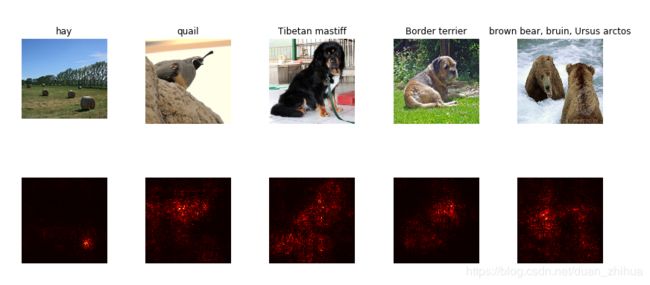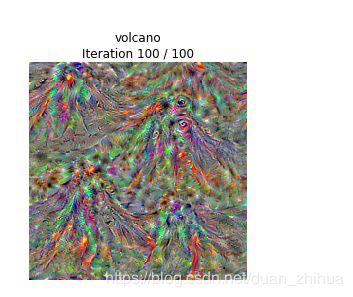cs231 Network Visualization (PyTorch)
cs231 Network Visualization (PyTorch)
在本笔记本中,我们将探索使用图像梯度来生成新图像。
在训练模型时,我们定义一个损失函数,用来测量我们当前对模型性能的损失程度,使用反向传播来计算损失相对于模型参数的梯度,并对模型参数执行梯度下降来最小化损失。在这里,我们会做一些稍微不同的事情。我们将从卷积神经网络模型开始,该模型已经被预训练用于对ImageNet数据集执行图像分类。我们将使用这个模型来定义一个损失函数,它量化我们当前对图像的损失度,然后使用反向传播来计算这个损失相对于图像的像素的梯度。然后,我们将保持模型固定,并对图像执行梯度下降以合成新图像,使损失最小化。
在本笔记本中,我们将探讨三种用于图像生成的技术:
-Saliency Maps:Saliency Maps是一种快速方法,用来判断图像的哪个部分影响网络做出的分类决策。
-Fooling Images:我们可以干扰输入图像,使其看起来与人类观察的图片一样,但会被预先训练的网络误分类。
-分类可视化:我们可以合成一个图像来最大化一个特定类的分类分数;这可以让我们知道当网络对那个类的图像进行分类时,它在寻找什么。本笔记本使用PyTorch。
# -*- coding: utf-8 -*-
import torch
import torchvision
import torchvision.transforms as T
import random
import numpy as np
from scipy.ndimage.filters import gaussian_filter1d
import matplotlib.pyplot as plt
from cs231n.image_utils import SQUEEZENET_MEAN, SQUEEZENET_STD
from PIL import Image
#%matplotlib inline
plt.rcParams['figure.figsize'] = (10.0, 8.0) # set default size of plots
plt.rcParams['image.interpolation'] = 'nearest'
plt.rcParams['image.cmap'] = 'gray'
def preprocess(img, size=224):
transform = T.Compose([
T.Resize(size),
T.ToTensor(),
T.Normalize(mean=SQUEEZENET_MEAN.tolist(),
std=SQUEEZENET_STD.tolist()),
T.Lambda(lambda x: x[None]),
])
return transform(img)
def deprocess(img, should_rescale=True):
transform = T.Compose([
T.Lambda(lambda x: x[0]),
T.Normalize(mean=[0, 0, 0], std=(1.0 / SQUEEZENET_STD).tolist()),
T.Normalize(mean=(-SQUEEZENET_MEAN).tolist(), std=[1, 1, 1]),
T.Lambda(rescale) if should_rescale else T.Lambda(lambda x: x),
T.ToPILImage(),
])
return transform(img)
def rescale(x):
low, high = x.min(), x.max()
x_rescaled = (x - low) / (high - low)
return x_rescaled
def blur_image(X, sigma=1):
X_np = X.cpu().clone().numpy()
X_np = gaussian_filter1d(X_np, sigma, axis=2)
X_np = gaussian_filter1d(X_np, sigma, axis=3)
X.copy_(torch.Tensor(X_np).type_as(X))
return X
# Download and load the pretrained SqueezeNet model.
model = torchvision.models.squeezenet1_1(pretrained=True)
# We don't want to train the model, so tell PyTorch not to compute gradients
# with respect to model parameters.
for param in model.parameters():
param.requires_grad = False
# you may see warning regarding initialization deprecated, that's fine, please continue to next steps
from cs231n.data_utils import load_imagenet_val
X, y, class_names = load_imagenet_val(num=5)
plt.figure(figsize=(12, 6))
for i in range(5):
plt.subplot(1, 5, i + 1)
plt.imshow(X[i])
plt.title(class_names[y[i]])
plt.axis('off')
plt.gcf().tight_layout()
# Example of using gather to select one entry from each row in PyTorch
def gather_example():
N, C = 4, 5
s = torch.randn(N, C)
y = torch.LongTensor([1, 2, 1, 3])
print(s)
print(y)
print(s.gather(1, y.view(-1, 1)).squeeze())
gather_example()
def compute_saliency_maps(X, y, model):
"""
Compute a class saliency map using the model for images X and labels y.
Input:
- X: Input images; Tensor of shape (N, 3, H, W)
- y: Labels for X; LongTensor of shape (N,)
- model: A pretrained CNN that will be used to compute the saliency map.
Returns:
- saliency: A Tensor of shape (N, H, W) giving the saliency maps for the input
images.
"""
# Make sure the model is in "test" mode
model.eval()
# Make input tensor require gradient
X.requires_grad_()
saliency = None
##############################################################################
# TODO: Implement this function. Perform a forward and backward pass through #
# the model to compute the gradient of the correct class score with respect #
# to each input image. You first want to compute the loss over the correct #
# scores (we'll combine losses across a batch by summing), and then compute #
# the gradients with a backward pass. #
##############################################################################
scores = model(X)
scores = scores.gather(1, y.view(-1, 1))
scores.backward(torch.ones_like(scores))
saliency = X.grad.data.abs().max(1)[0]
##############################################################################
# END OF YOUR CODE #
##############################################################################
return saliency
def show_saliency_maps(X, y):
# Convert X and y from numpy arrays to Torch Tensors
X_tensor = torch.cat([preprocess(Image.fromarray(x)) for x in X], dim=0)
y_tensor = torch.LongTensor(y)
# Compute saliency maps for images in X
saliency = compute_saliency_maps(X_tensor, y_tensor, model)
# Convert the saliency map from Torch Tensor to numpy array and show images
# and saliency maps together.
saliency = saliency.numpy()
N = X.shape[0]
for i in range(N):
plt.subplot(2, N, i + 1)
plt.imshow(X[i])
plt.axis('off')
plt.title(class_names[y[i]])
plt.subplot(2, N, N + i + 1)
plt.imshow(saliency[i], cmap=plt.cm.hot)
plt.axis('off')
plt.gcf().set_size_inches(12, 5)
plt.show()
show_saliency_maps(X, y)
def make_fooling_image(X, target_y, model):
"""
Generate a fooling image that is close to X, but that the model classifies
as target_y.
Inputs:
- X: Input image; Tensor of shape (1, 3, 224, 224)
- target_y: An integer in the range [0, 1000)
- model: A pretrained CNN
Returns:
- X_fooling: An image that is close to X, but that is classifed as target_y
by the model.
"""
# Initialize our fooling image to the input image, and make it require gradient
X_fooling = X.clone()
X_fooling = X_fooling.requires_grad_()
learning_rate = 1
##############################################################################
# TODO: Generate a fooling image X_fooling that the model will classify as #
# the class target_y. You should perform gradient ascent on the score of the #
# target class, stopping when the model is fooled. #
# When computing an update step, first normalize the gradient: #
# dX = learning_rate * g / ||g||_2 #
# #
# You should write a training loop. #
# #
# HINT: For most examples, you should be able to generate a fooling image #
# in fewer than 100 iterations of gradient ascent. #
# You can print your progress over iterations to check your algorithm. #
##############################################################################
for i in range(100):
scores = model(X_fooling)
if scores.argmax(1)[0] == target_y:
break
scores = scores[:, target_y]
scores.backward()
dx = X_fooling.grad.data
dx = learning_rate * dx / torch.norm(dx)
X_fooling.data += dx
X_fooling.grad.zero_()
##############################################################################
# END OF YOUR CODE #
##############################################################################
return X_fooling
idx = 0
target_y = 6
X_tensor = torch.cat([preprocess(Image.fromarray(x)) for x in X], dim=0)
X_fooling = make_fooling_image(X_tensor[idx:idx+1], target_y, model)
scores = model(X_fooling)
assert target_y == scores.data.max(1)[1][0].item(), 'The model is not fooled!'
X_fooling_np = deprocess(X_fooling.clone())
X_fooling_np = np.asarray(X_fooling_np).astype(np.uint8)
plt.subplot(1, 4, 1)
plt.imshow(X[idx])
plt.title(class_names[y[idx]])
plt.axis('off')
plt.subplot(1, 4, 2)
plt.imshow(X_fooling_np)
plt.title(class_names[target_y])
plt.axis('off')
plt.subplot(1, 4, 3)
X_pre = preprocess(Image.fromarray(X[idx]))
diff = np.asarray(deprocess(X_fooling - X_pre, should_rescale=False))
plt.imshow(diff)
plt.title('Difference')
plt.axis('off')
plt.subplot(1, 4, 4)
diff = np.asarray(deprocess(10 * (X_fooling - X_pre), should_rescale=False))
plt.imshow(diff)
plt.title('Magnified difference (10x)')
plt.axis('off')
plt.gcf().set_size_inches(12, 5)
plt.show()
def jitter(X, ox, oy):
"""
Helper function to randomly jitter an image.
Inputs
- X: PyTorch Tensor of shape (N, C, H, W)
- ox, oy: Integers giving number of pixels to jitter along W and H axes
Returns: A new PyTorch Tensor of shape (N, C, H, W)
"""
if ox != 0:
left = X[:, :, :, :-ox]
right = X[:, :, :, -ox:]
X = torch.cat([right, left], dim=3)
if oy != 0:
top = X[:, :, :-oy]
bottom = X[:, :, -oy:]
X = torch.cat([bottom, top], dim=2)
return X
def create_class_visualization(target_y, model, dtype, **kwargs):
"""
Generate an image to maximize the score of target_y under a pretrained model.
Inputs:
- target_y: Integer in the range [0, 1000) giving the index of the class
- model: A pretrained CNN that will be used to generate the image
- dtype: Torch datatype to use for computations
Keyword arguments:
- l2_reg: Strength of L2 regularization on the image
- learning_rate: How big of a step to take
- num_iterations: How many iterations to use
- blur_every: How often to blur the image as an implicit regularizer
- max_jitter: How much to gjitter the image as an implicit regularizer
- show_every: How often to show the intermediate result
"""
model.type(dtype)
l2_reg = kwargs.pop('l2_reg', 1e-3)
learning_rate = kwargs.pop('learning_rate', 25)
num_iterations = kwargs.pop('num_iterations', 100)
blur_every = kwargs.pop('blur_every', 10)
max_jitter = kwargs.pop('max_jitter', 16)
show_every = kwargs.pop('show_every', 25)
# Randomly initialize the image as a PyTorch Tensor, and make it requires gradient.
img = torch.randn(1, 3, 224, 224).mul_(1.0).type(dtype).requires_grad_()
for t in range(num_iterations):
# Randomly jitter the image a bit; this gives slightly nicer results
ox, oy = random.randint(0, max_jitter), random.randint(0, max_jitter)
img.data.copy_(jitter(img.data, ox, oy))
########################################################################
# TODO: Use the model to compute the gradient of the score for the #
# class target_y with respect to the pixels of the image, and make a #
# gradient step on the image using the learning rate. Don't forget the #
# L2 regularization term! #
# Be very careful about the signs of elements in your code. #
########################################################################
scores = model(img)
scores = scores[:, target_y]
scores.backward()
dx = img.grad.data + 2 * l2_reg * img.data
img.data += learning_rate * (dx / torch.norm(dx))
img.grad.zero_()
########################################################################
# END OF YOUR CODE #
########################################################################
# Undo the random jitter
img.data.copy_(jitter(img.data, -ox, -oy))
# As regularizer, clamp and periodically blur the image
for c in range(3):
lo = float(-SQUEEZENET_MEAN[c] / SQUEEZENET_STD[c])
hi = float((1.0 - SQUEEZENET_MEAN[c]) / SQUEEZENET_STD[c])
img.data[:, c].clamp_(min=lo, max=hi)
if t % blur_every == 0:
blur_image(img.data, sigma=0.5)
# Periodically show the image
if t == 0 or (t + 1) % show_every == 0 or t == num_iterations - 1:
plt.imshow(deprocess(img.data.clone().cpu()))
class_name = class_names[target_y]
plt.title('%s\nIteration %d / %d' % (class_name, t + 1, num_iterations))
plt.gcf().set_size_inches(4, 4)
plt.axis('off')
plt.show()
return deprocess(img.data.cpu())
dtype = torch.FloatTensor
# dtype = torch.cuda.FloatTensor # Uncomment this to use GPU
model.type(dtype)
target_y = 76 # Tarantula
# target_y = 78 # Tick
# target_y = 187 # Yorkshire Terrier
# target_y = 683 # Oboe
# target_y = 366 # Gorilla
# target_y = 604 # Hourglass
out = create_class_visualization(target_y, model, dtype)
# target_y = 78 # Tick
# target_y = 187 # Yorkshire Terrier
# target_y = 683 # Oboe
# target_y = 366 # Gorilla
# target_y = 604 # Hourglass
target_y = np.random.randint(1000)
print(class_names[target_y])
X = create_class_visualization(target_y, model, dtype)
运行结果如下:
。。。。。。


